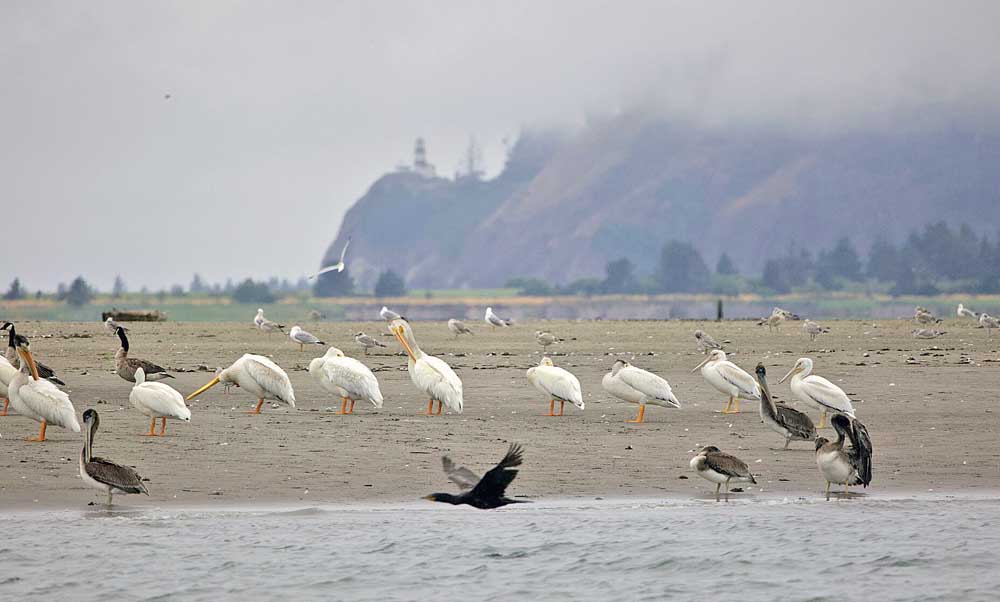River island critical communal roost for pelicans
Published 12:30 am Thursday, July 29, 2021

- The Columbia River estuary provides a unique opportunity to see brown and white pelicans together — as here with Cape Disappointment Lighthouse in the background. Public access to East Sand Island is prohibited during nesting season.
Many people are aware of the use of East Sand Island near Ilwaco by double-crested cormorants and Caspian terns and the salmon-related management issues surrounding those birds, thanks partly to local news coverage.
Trending
Far fewer people are aware of how important this Columbia River estuary island is to California brown pelicans. East Sand Island is a critical communal roost for nonbreeding brown pelicans that migrate north to the Pacific Northwest to fish for anchovy and other coastal pelagic prey species in the summer and fall.
Pelicans gather to roost onshore at night and much of the day when not foraging. Island habitat protects them from predators and human disturbances while they rest, preen their plumage, socialize and keep alert to cues indicating good fishing conditions.
While onshore, they practice stick handling, courtship, dominance displays and other ritualized behaviors. Time to work on these skills and acquire the fat needed for return migration will help them nest successfully down south in the future.
Trending
Science surveys
The northern limit of the breeding range is in Southern California and includes the Channel Islands, offshore islands and mangrove forests along the Baja California, Mexico, peninsula and the desert islands in the Gulf of California, Mexico.
This year, Pelican Science, in collaboration with the Columbia River Estuary Study Taskforce, is conducting monthly boat-based surveys of East Sand Island to monitor abundance, age structure and habitat use by brown pelicans. Our count on July 16 was over 1,500 brown pelicans, which was about 10 times higher than the June 2021 count.
Population structure was skewed toward young birds. About 60% of the total included birds that fledged this year or are too young to breed. These birds have come a long way in their short lives to join us here, at anywhere from 1,000 to 2,500 miles from their natal colonies.
A story of one pelican
During the boat surveys we search for field readable, color-banded pelicans that are sometimes only detected afterward in our photographs. We found several in July and were able to read the codes for two of them. Tracking the movements of individuals provides insight into population level dynamics and can provide some interesting stories about these long-lived birds. For example, we now know that H06 is back in the region.
H06 is a brown pelican captured by wildlife rehabilitators in Northern California on Christmas Eve 2010. That year, many pelicans stayed unusually late in the Pacific Northwest and had a perilous return migration in winter when environmental conditions suddenly shifted and prey became unavailable.
H06 was found near San Francisco starving, hypothermic and unable to fly any further, having lost about 40% of his normal body weight. After a few weeks of care and feeding by International Bird Rescue, he was released under the Golden Gate Bridge with a blue, individually coded color leg band. Since then, we have observed this bird six times in the Pacific Northwest during summer, and once in the San Francisco Bay Area in November, indicating an appropriate seasonal return trip south.
We now know that not only has this bird survived to be at least 15 years old, but he returns traditionally to fish the Columbia and Grays Harbor region in summer, despite that one life-threatening experience when he lingered north too long.
White pelicans increase
While brown pelican counts have been trending down in recent years in association with a variety of factors, white pelicans have visibly increased in our area.
The Columbia River estuary provides a unique opportunity to see brown and white pelicans together. White pelicans nest upriver on Miller Sands and are typically freshwater birds. They feed by scooping fish from the surface and do not perform the dramatic aerial plunge diving that brown pelicans do over the sea. While brown pelicans are large, they seemed dwarfed standing next to the group of 43 white pelicans that were also roosting on East Sand Island this month.
East Sand Island technically lies within Clatsop County and is owned and managed by the U.S. Army Corps of Engineers. Public access is forbidden during the seabird breeding season. Pelican Science is a research, conservation and educational nonprofit based in Astoria. We urge people to take care to avoid disturbing large roosting groups of pelicans whenever possible and hope that you enjoy watching them fly and feast while they are here.









